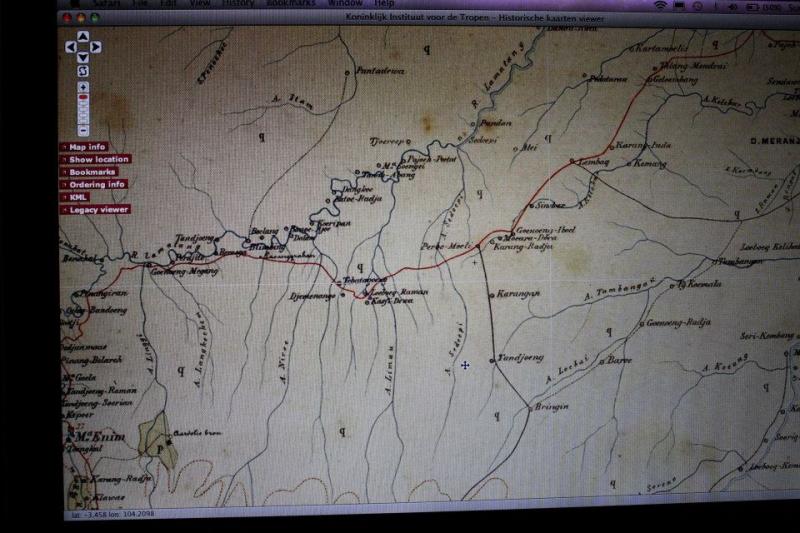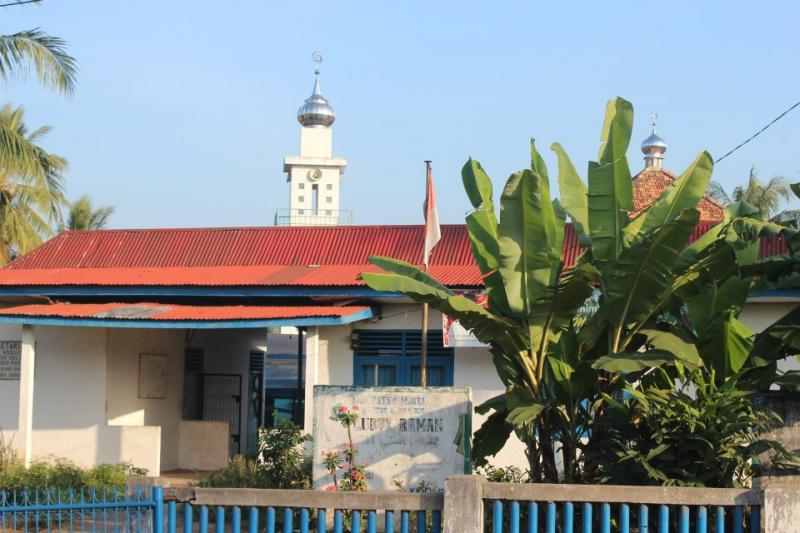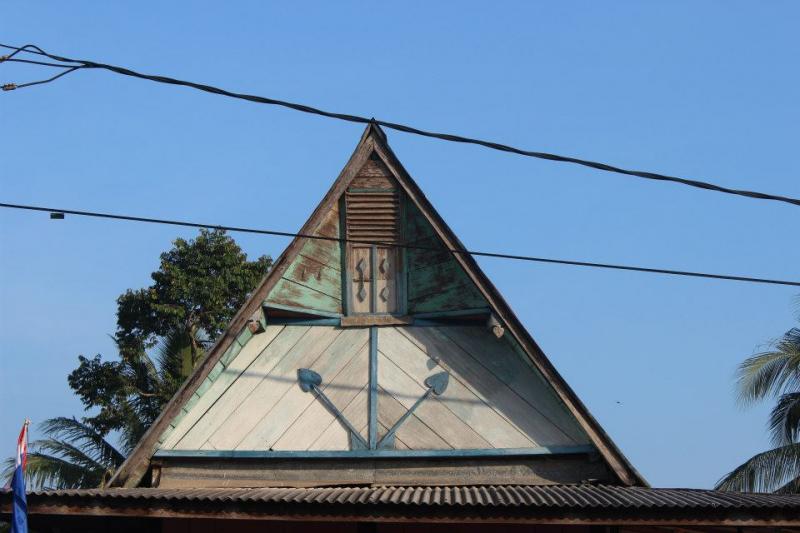I travelled through South Sumatra after visiting my potential field sites in West Sumatra because I wanted to see some of the National Parks (Kerenci) and archaeological sites (Pasemah, Palembang) not because I had a real thought that I would find Wallace's "house" and field site at Lubuk Rahman (“Lobo Raman” in The Malay Archipelago] in South Central Sumatra. But because I was going through Palembang, I decided to spend a few days looking for his field site. To locate the locality I perused the wonderful on-line Colonial map site of the Royal Tropical Museum in Amsterdam (www.kits.nl) and located a map by R.D.M Verbeck from 1880 which indicated all the villages noted by Wallace on his journey west from Palembang to the Rembang region.
 Map by R.D.M Verbeck
Map by R.D.M Verbeck
“The houses are raised about six feet on posts, the best being entirely built of planks, others of bamboo. The former are always more or less ornamented with carving, and have high pitched roofs and ornamented eaves.” (The Malay Archipelago 1962 pp. 96 Dover Edition 10th)
Things looked bleak for finding anything resembling Wallace's original structure. His description of the village houses having "high-pitched roofs" with "highly ornamented" "over-hanging gables" are clearly a thing of the past. In West Sumatra you see many well-preserved houses which exaggerate this style, some well over a hundred years old, maintained by families as a sort of "pustaka" (inheritance). In fact, the illustration (#14 in The Malay Archipelago modified from a photograph by Robinson) is clearly of a West Sumatran rumah adat (traditional house) of the Minangkabau style of West Sumatra, not of the Rembang peoples of South Central Sumatra. Old photos and some preserved villages in the region indicate the houses of Rembang had much lower gables, were narrower, and had a verandah on the narrower front end (see http://sphotos-b.xx.fbcdn.net/hphotos-prn1/21040_285297472259_1862010_n.jpg). Minang rumah adat have the verandah on the long side of the structure.
From Benkulu on the West coast to Pagar Alam (where there are megalithic carvings) on some very small back roads I saw nothing like Wallace's description. Instead standard brick shoplots and a more modern straight-roofed red-tiled "Dutch" building style prevailed. I was thus downcast on the bus trip towards Lubuk Rahman. That anxiety increased after I passed through Maura Enem, where the last distant patches of forest on some of the bukits (hills) transformed into mind-numbingly repetitive palm-oil and rubber plantations. It was almost dusk as I passed through the outskirts of the small village of Lubuk Rahman and we went up a small rise in the undulating topography.
 Lubuk Rahman
Lubuk Rahman
At the top, at a cross section, was a curious two-story house with a pitched gable roof of corrugated iron (or rusting, no longer galvanized, tin) and a carved frieze front. It literally jumped out at me as being the odd structure in a two hundred mile journey...then it was past me as my bus rolled on.
 The curious house
The curious house
 Carved frieze front of the house
Carved frieze front of the house
I decided to stay the night in Prabamulih, the headquarters of "Pertamina, the national oil-company of Indonesia, about 30 kilometers to the east, and make my way back to Lubuk Raman in better light the next morning. While most Sumatran towns have some sort of "gateway" monument featuring a giant sculptured durian, or a seahorse, or orangutan, rafflesia, or similar object of civic pride...Prabumulih's is a functional, pumping oil well in the middle of main street! I overnighted in the over-priced, basic "Agung Hotel" because the others (not much cheaper) were clearly "short-time" dens for bus drivers or oil workers with their monthly payrolls out for a night of "entertainment". Wallace stayed a fortnight in Moera Doea, a village that has since been absorbed by Prabumulih, but found that his collections here were poor.
I was up at 8 AM and took a local bus back the 20km to Lubuk Rahman. Upon hopping out I took some photos of this odd building and asked the curious woman across the street why it has a pitched roof, how old is it (“very”..she remembered it there when she was a child), and then said I should talk to the walikota (=mayor), Pak Bastoni B.Sc. I walked about 20 yards and there he was, washing his car. I introduced myself in my basic Indonesian and we had a chat about the house over tea and cookies. He agreed that it was "very old, maybe the first house here" and "strange" - "some people call it the Minang House".
"Did Minang people live there?" "No, it's just a name because it has the old roof and strange carving".
I asked how far it was to the other villages in the area, to Tabatagung, Ulu Niroe and Kasih Dua? He was surprised that I knew the names of these but told me it was about about 1-2 km to these small homesteads. "People came to live here from the other villages because this was on the main road."
I asked him how far to forest today..."about 7km to the South of the junction at the house there is a little on the river".
"Are there animals in the forest?" "Some monkeys, maybe siamang still."
"Is that the Sungai Lematang?" "No that's to the north"
I then showed him Wallace's book and pointed out that this English scientist had stayed and collected butterflies, birds and other animals at Lubuk Rahman 150 years ago. I showed him some of the illustrations from The Malay Archipelago and roughly translated the passages about Wallace's visit. I pointed out that he was “Darwin’s friend and developed the theory of evolution at the same time”. He had heard about Darwin and evolution and was excited that such an important scientist had collected in his small town. He agreed that maybe the old house was a "passangrahan" ( a Dutch government guest house built a days walk along the highways, about every 10-12 miles).
We drove back to the building and I asked him and the residents about the carvings with the heart-tipped arrows. They didn't know of the symbolic meaning, traditional or otherwise. "Maybe Dutch, if it was a passangrahan?" I suspect they are right.
 Side view of the house.
Side view of the house.
Clearly the building has undergone some sweeping renovations, with bricking in the bottom story...the replacement of the atap thatch roof with the metal one, and perhaps periodic repairs of the wood and hardware. But it has a nice verandah on the wooden plank second story, is at the crossroad to the south and is on the highest elevation on the road. The bricked understory appears to have been an afterthought, as the second level is only entered by going outside and up an exterior wooden stairway to the verandah. That Wallace stayed in a structure with an open understory is clear from his description of the apparatus built for his pet siamang that he had captured:
“we had released it and given it two poles under the verandah to hang upon…and would swing itself with great rapidity…from pole to pole and onto the rafters of the verandah.”
The nearest stream is the Niru, which is a tributary of the Lematang. It's sheer oddness and position - plus its fit with Wallace's description makes me think this really could be Wallace's field site and the guest house where he remained a month.
It was at Lubuk Rahman where Wallace found examples of the Batesian mimics, Papilio memnon and P. coon. It was also here that he found Kallima paralekta, whose upper wings were purple and orange, but which was a near perfect mimic of dead leaves when its wings were not extended.

Add new comment